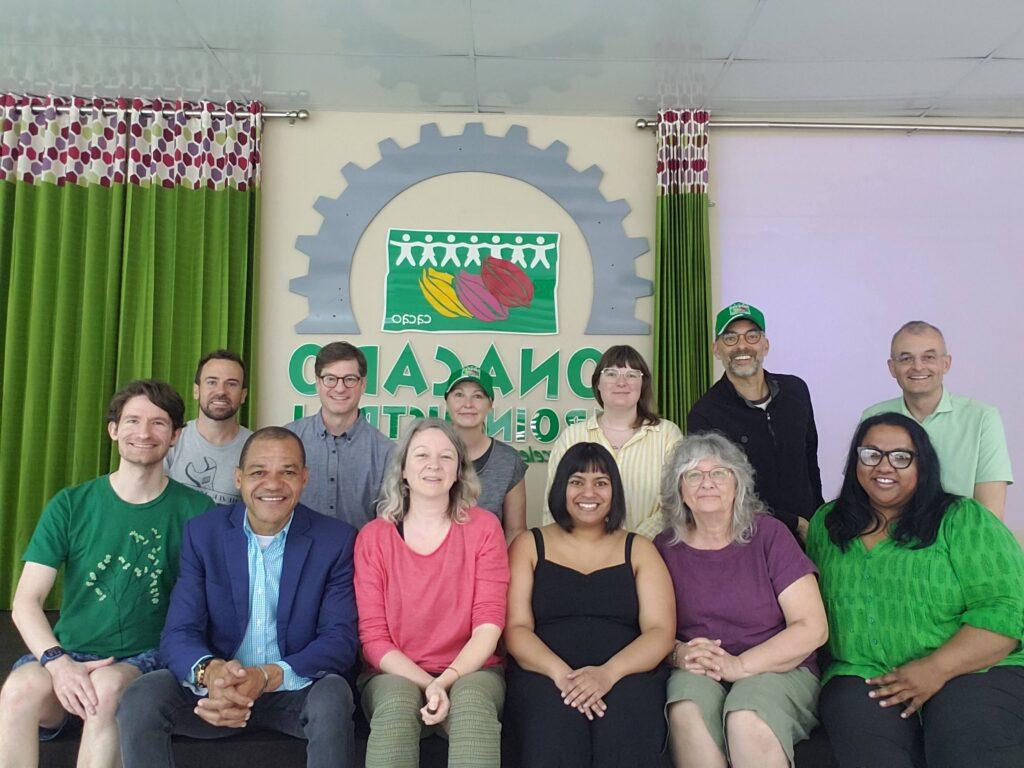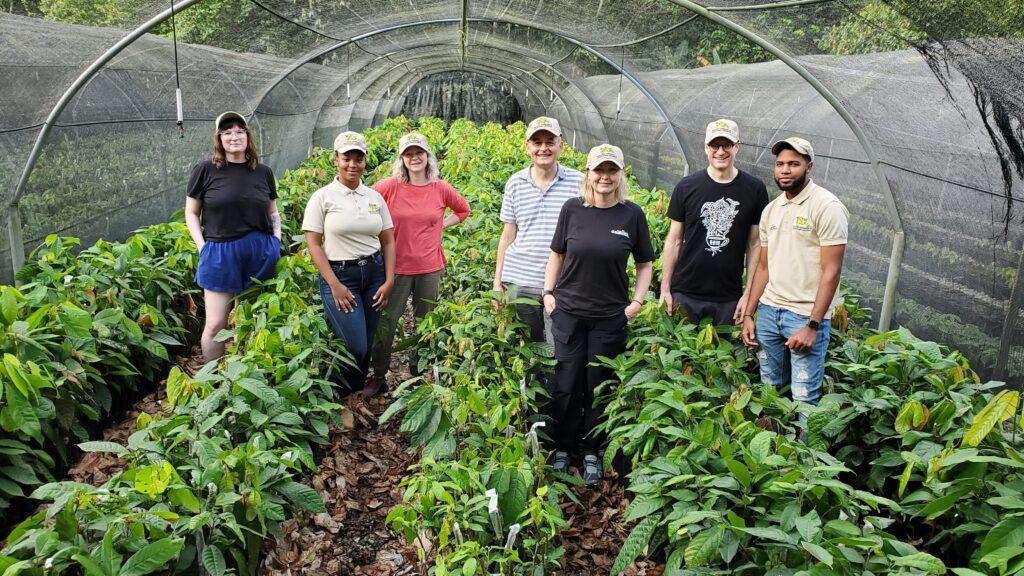Visiting the producers we work with is of great importance to us at Camino. It allows us to consolidate our ties and establish fruitful exchanges; we share challenges, opportunities, projects on the go, and get a better sense of the realities on the ground. Since our last visit to Peru in the summer of 2018, like so many others, the pandemic left us counting the days until our next chance to meet in person. During this waiting period, confined to our respective countries, we and our partner growers took the opportunity to improve our technological communication tools – keeping in touch via teleconferencing platforms until we could see each other again.
As the restrictions lifted, we set about organizing a new field visit which took place in late March this year, in the Dominican Republic. In partnership with two local producer co-operatives, FUNDOPO and CONACADO, as well as our Swiss chocolate bar partner and our sister co-operative, we formed a new delegation with the aim of strengthening our relationships with cocoa-producing families, their co-operatives, and local communities.
PART1
Agents of change

Our Camino delegation was truly representative of the agents of change. It comprised three dedicated Camino team members (Kelly, Caitlin, and myself, Mélanie), three investors from our co-operative Sunaina, Derek and Ben), as well as a chocolatier and educator (Renu), and a fair trade advocate (Bev). On site, we were joined by the head of our Swiss partner’s chocolate supply chain (Sandro) and the head of the cocoa supply chain at our sister co-operative (Dary), Equal Exchange.
The delegation perfectly reflected the diversity of actors involved in our supply chain, representing all the links from South to North; each participant committed to promoting fair trade practices and making the democratic organizational model shine. Together, we aspire to create a positive and lasting impact, working towards a more equitable and environmentally friendly chocolate industry.
The realities of climate change
As we arrived in Santiago, in the north of the Dominican Republic, we learned that it hadn’t rained in the region for over two months. The air was hot, and we were already feeling the knots in our stomachs at the thought of seeing firsthand how the drought was impacting communities. When we set out to visit the cocoa-producing farms, we were immediately struck by the state of the cocoa trees. Beneath our footsteps was a thick layer of cocoa leaves, crunching as we walked, a stark indicator of foliage loss due to the extended drought. Many cocoa pods, the fruit in which you find the cocoa beans, had dried out on the trunks before reaching maturity. Meanwhile, CONACADO had implemented voluntary water cut-offs at their cocoa processing facility to better manage resources while they continued to weather the drought.

For several decades, the Dominican Republic has had to contend with the effects of climate change, which have only become more pronounced over the years: coastal erosion due to rising sea levels, flooding, storms, hurricanes, and drought.
According to a recent report by the Instituto Dominicano de Desarrollo Integral, Inc (IDDI – 2018), access to water is limited in many parts of the country, which means that agricultural production depends mainly on rainfall (p.8). Yet average rainfall in the Dominican Republic has dropped by no less than 5.0 mm per month (4.5%) and per decade since reporting began in 1960 (p.10). Meanwhile, water demand is set to increase by 13% between now and 2030 (p.15).
Growing cocoa in the Dominican Republic
Our visit to the Dominican Republic began with a meeting with the CONACADO cocoa producers’ co-operative. Abel Fernandez, Export Manager and long-time friend, warmly welcomed our Camino delegation. Over coffee and hot cocoa, we took some time to catch up with each other and give the newcomers a chance to meet part of the team at CONACADO. Abel then discussed the co-operative’s current challenges, successes, and opportunities.

It’s important to know that the Dominican Republic is now the world’s 10th largest cocoa producer and a leader in producing and exporting organic cocoa. However, this was not always the case. In the 1980s, the cocoa bean market was mainly controlled by a handful of family businesses. Abel explained that around 95% of exported cocoa beans were unfermented and often sold at less than the world price. “There was no one to take care of the farmers”, he added. What’s more, cocoa farming was not a government priority, unlike rice, and living conditions for cocoa farmers were deplorable.
It was in this context that CONACADO was born in 1985 as part of a development project that aimed to improve cocoa bean quality, yields, and export volumes, as well as the quality of life of producers. After successfully demonstrating that cocoa fermentation could increase farmers’ incomes, CONACADO expanded its work by providing education to cocoa farmers and organizing them into associations called “bloques” within a given geographical area.
The co-operative then turned to the commercialization of their project, focusing on finding niche markets for their high-quality cocoa, including organic cocoa farming.



In 2008, CONACADO acquired a plant for processing cocoa beans into semi-finished products such as cocoa powder, cocoa butter and cocoa nibs. Today, the co-operative includes over 10,000 members producing 17 metric tons of cocoa beans annually, of which 13.5 metric tons are organic. CONACADO also owns many cocoa bean fermentation and drying centers across the country, enabling the co-op to guarantee bean quality and maintain greater uniformity.
CONACADO members produce around 25% of the cocoa exported by the Dominican Republic, and the organization has become a powerful alternative for small producers. The co-operative’s success in improving quality and marketing is reflected in the fact that 70% of cocoa is sold as high-quality fermented beans, mainly to European niche markets focused on organic, biodynamic, and fair trade products.
Over the years, CONACADO has not only improved the lives of its cocoa-growing members in the Dominican Republic but also played a key role in positioning the country as a leader in organic cocoa production. Thanks to their commitment to sustainable and fair practices and their focus on quality, they have succeeded in changing the landscape of the cocoa industry and offering better prospects for small-scale cocoa farmers. CONACADO is an inspiring example of positive transformation in cocoa farming.
Living with the producers
Following a visit to one of CONACADO’s fermentation and drying facilities at the San Francisco “bloque”, we continued our journey along the supply chain to meet directly with the cocoa producers of the FUNDOPO association. This association, founded in the early 2000s, is our primary source of cocoa beans used in our chocolate bars. Like CONACADO, FUNDOPO has organized its producer groups across the country, divided into four distinct regions.


To meet FUNDOPO’s producer members, we headed south towards Santo Domingo, in the San Cristobal region, about an hour and a half from Villa Altagracia. In the small community of Jamey, nestled on the slopes of medium-altitude mountains, we spent two days in the company of cocoa producer families, members of FUNDOPO. Divided among six families, we were welcomed into the homes of our hosts, who graciously took the time to share their lives with us for a few days. “Staying with host families of cocoa producers was a highlight of the trip for me”, shared Bev.

Most cocoa farmers live with rudimentary means in homes made of metal sheets and wood. All of the homes we stayed in have electricity with some level of access to the internet, some with DIY setups that are at times unreliable. Access to running water is available on their farm and in most of their houses, although these installations seemed recent. A few years ago, before the installation of the running water system with FUNDOPO’s support, most families had to travel to draw their water from the river below. The cooking areas are located in shelters separate from their homes, housing large stone stoves for wood-fired cooking. “The producers were extremely welcoming, and I had a great time exploring the surrounding area with my host on his motorcycle, also making a few discoveries, grabbing snacks from the little store next door, and visiting the local fermentation center,” Ben told us.



Their livelihoods and their foods are all around their homes: cocoa trees, as well as other fruit trees such as mango, avocado, banana, and various other species. Farm chickens mingle with other domestic animals, providing some staple foods, such as eggs; corner stores, a walk or short drive up the road, supply the rest of their day-to-day needs. While walking with Pépé, a cocoa farmer I stayed with, he shared that it hadn’t rained for five months in his region and told me he had never seen anything like it. There is no irrigation system, so the vegetation – their livelihood and food – has to make do with the water it receives naturally.
Read PART 2



